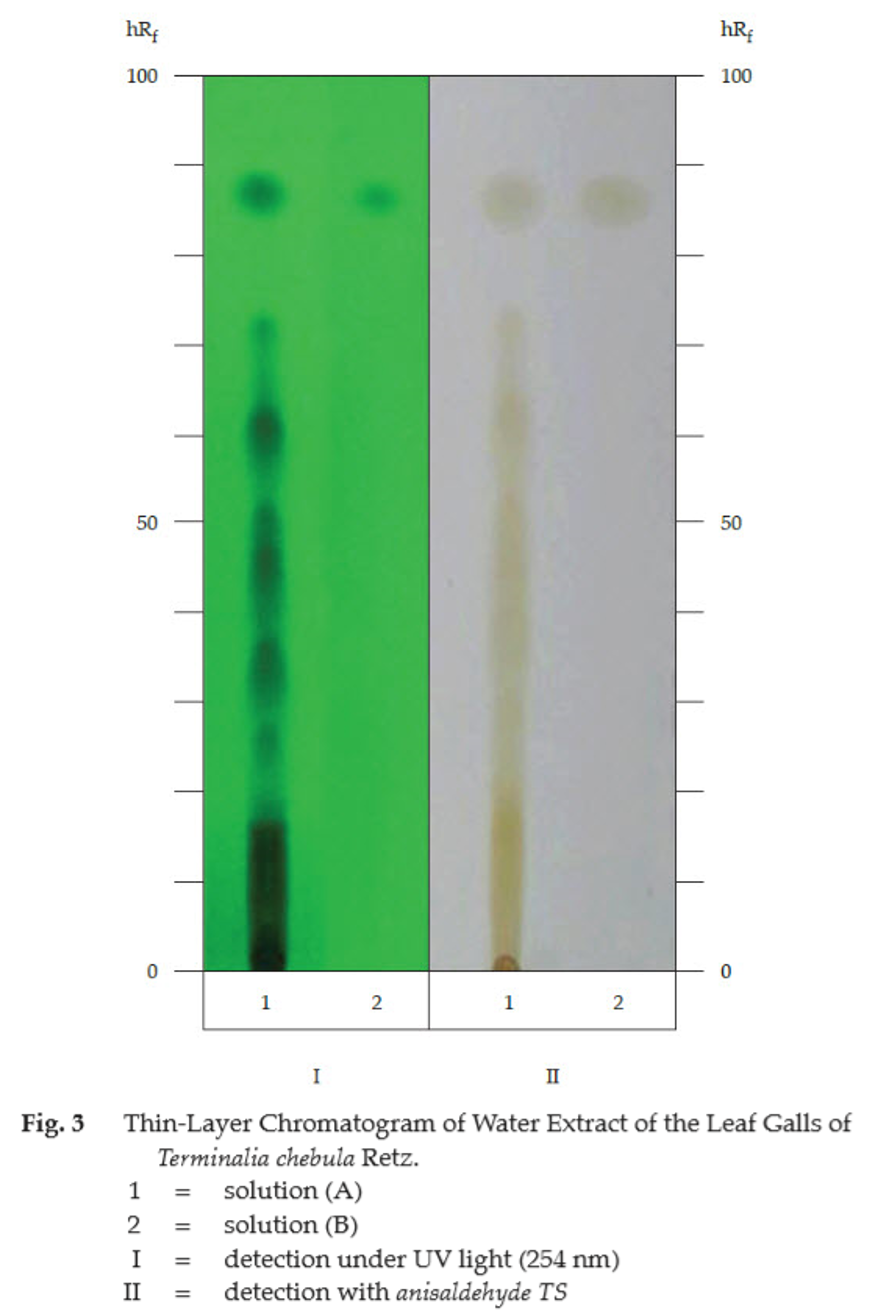ตำรามาตรฐานยาสมุนไพรไทย
Thai Herbal Pharmacopoeia
สำนักยาและวัตถุเสพติด กรมวิทยาศาสตร์การแพทย์ กระทรวงสาธารณสุข
Bureau of Drug and Narcotic, Department of Medical Sciences, Ministry of Public Health(Tinospora crispa (L.) Hook.f. & Thomson)
(Nelumbo nucifera Gaertn.)
(Centella asiatica (L.) Urb.)
(Centella Dry Extract)
(Centella Cream)
(Mesua ferrea L.)
(Piper sarmentosum Roxb.)
(Piper sarmentosum Roxb.)
(Pterocarpus santalinus L. f.)
(Santalum album L.)
(Senna tora (L.) Roxb.)
(Senna alata (L.) Roxb.)
(Senna Alata Tea)
(Piper retrofractum Vahl)
(Myristica fragrans Houtt)
(Andrographis paniculata (Burm. f.) Nees)
(Andrographis Capsules)
(Allium ascalonicum L.)
(Ocimum tenuiflorum L.)
(Curcuma longa L.)
(Turmeric Capsules)
(Turmeric Dry Extract)
(Turmeric Dry Extract Capsules)
(Arcangelisia flava (L.) Merr.)
(Curcuma sp.)
Harrisonia perforata (Blanco) Merr.
(Aristolochia pierrei Lecomte)
(Zingiber officinale Roscoe)
(Ginger Capsules)
(Ginger Tea)
(Cassia fistula L.)
(Nardostachys jatamansi (D. Don) DC.)
(Angelica sinensis (Oliv.) Diels)
Artemisia annua L.
(Ligusticum sinense Oliv. cv. Chuanxiong)
(Neopicrorhiza scrophulariiflora Pennell)
(Atractylodes lancea (Thunb.) DC.)
(Aucklandia lappa Decne)
(Terminalia chebula Retz.)
(Angelica dahurica (Hoffm.) Benth. & Hook. f. ex Franch. & Sav. var. dahurica)
(Kaempferia parviflora Wall. ex Baker)
(Hibiscus sabdariffa L.)
(Roselle Tea)
(Allium sativum L.)
(Zingiber zerumbet (L.) Sm.)
(Wurfbainia testacea (Ridl.) Škorničk.& A. D. Poulsen)
(Cannabis sativa L.)
(Myristica fragrans Houtt)
(Dracaena cochinchinensis (Lour.) S. C. Chen)
(Ficus racemosa L.)
(Hyptis suaveolens (L.) Poit.)
Clerodendrum indicum (L.) Kuntze
(Phyllanthus emblica L.)
(Citrus hystrix DC.)
(Citrus hystrix DC.)
(Areca catechu L.)
(Momordica charantia L.)
Moringa oleifera Lam.
(Aegle marmelos (L.) Corrêa)
(Solanum trilobatum L.)
(Morus alba L.)
Gynostemma pentaphyllum(Thunb.)
Makino
(Clinacanthus nutans (Burm. f.) Lindau)
(Cissus quadrangularis L.)
(Mimusops elengi L.)
(Zingiber montanum (J. König) Link. ex A. Dietr.)
(Piper betle L.)
(Capsicum annuum L.)
(Capsicum Oleoresin)
(Capsicum Gel)
(Piper nigrum L.)
(Piper nigrum L.)
(Eurycoma longifolia Jack)
(Thunbergia laurifolia Lindl.)
(Piper wallichii (Miq.) Hand.-Mazz.)
Senna garrettiana (Craib) H. S. Irwin & Barneby
(Terminalia bellirica (Gaertn.) Roxb.)
(Terminalia chebula Retz.)
(Caesalpinia bonduc (L.) H. Roxb.)
(Tarlmounia elliptica (DC.) H. Rob., S. C. Keeley, Skvaria & R. Chan)
(Hog Creeper Vine Dry Extract Capsiles)
(Hog Creeper Vine Dry Extract)
(Brachypterum scandens (Roxb.) Miq.)
(Lepidium sativum L.)
(Nigella sativa L.)
(Cuminum cyminum L.)
(Foeniculum vulgare Mill.)
(Plantago ovata Forssk.)
(Pimpinella anisum L.)
(Carum carvi L.)
(Anethum graveolens L.)
(Trachyspermum ammi (L.) Sprague)
Albizia procera (Roxb.) Benth.
(Acorus calamus L.)
(Tiliacora triandra (Colebr.) Diels)
Cyanthillium cinereum (L.) H. Rob.
(Orthosiphon aristatus (Blume) Miq.)
Murdannia loriformis (Hassk.) R. S. Rao & Kammathy
(Capparis micracantha DC.)
(Chrysopogon zizanioides (L.) Roberty)
(Cyperus rotundus L.)
(Cannabis sativa L.)
(Syzygium aromaticum (L.) Merr. & L. M. Perry)
(Boesenbergia rotunda (L.) Mansf.)
(Acanthus ebracteatus Vahl)
(Acanthus ilicifolius L.)
(Kaempferia galanga L.)
(Curcuma comosa Roxb.)
Betula alnoides Buch.-Ham. ex D. Don
Cannabis sativa L.
Carthamus tinctorius L
Mitragyna speciosa (Korth.) Havil
Mallotus repandus (Rottler) Müll. Arg
Azadirachta indica A. Juss. var. siamensis Valeton
Azadirachta indica A. Juss. var. siamensis Valeton
Punica granatum L.
Rhinacanthus nasutus (L.) Kurz
Baliospermum solanifolium (Burm.) Suresh
Curcuma aeruginosa Roxb
Boesenbergia kingii Mood & L. M. Prince
Senegalia rugata (Lam.) Britton & Rose
Acacia concinna (Willd.) DC.
Senegalia rugata (Lam.) Britton & Rose
Acacia concinna (Willd.) DC.
Senna alexandriana Mill. var. alexandriana
Cassia acutifolia Delile, Cassia angustifolia Vahl
Butea superba Roxb. ex Willd.
[Plaso superba (Roxb. ex Willd.) Kuntze, Rudolphia superba (Roxb. ex Willd.) Poir.
Pueraria candollei Graham
ex Benth. var. mirifica (Airy Shaw & Suvat.) Niyomdham
Streblus asper Lour.
Suregada multiflora (A. Juss.) Baill. (Gelonium
multiflorum A. Juss.
Terminalia Chebula Gall is the dried leaf gall of Terminalia chebula Retz. (Family Combretaceae), Herbarium Specimen Number: DMSC 899, Crude Drug Number: DMSc 0937.
Constituents Terminalia Chebula Gall contains phenolic acids (e.g., gallic acid) and hydrolyzable tannins (e.g., chebulagic acid, tannic acid). It also contains flavonoids, triterpenoids, etc.
Description of the plant (Figs. 1a, 1b) Medium- to large-sized tree, up to 30 m tall; up to 1.3 m in girth; bark rough, scaly; shoot and young leaves usually rusty villous. Leaves simple, opposite, broadly ovate to ovate-elliptic, 8 to 15 cm long, 6 to 10 cm wide, apex acute or abruptly acuminate, base cuneate, slightly cordate or rounded, coriaceous, glabrescent, nerves obscure above, slightly raised and usually brownish pubescent beneath; petiole 1 to 3 cm long, glabrous or sparsely pubescent with a pair of nodular glands near leaf base. Inflorescence axillary or terminal panicle, usually with 3 to 6 spikes; spike 3 to 6 cm long; rachis pubescent. Flower 3 to 4 mm in diameter; bract nearly glabrous, 1.5 to 2 mm long; calyx tube infundibuliform, calyx segment triangular, outside glabrous, inside densely villous; stamen 3 to 4 mm long; disc lobed, densely villous; ovary inferior, glabrous, ovoid, about 1 mm long, style glabrous, 2.5 to 3 mm long. Fruit drupe, subglobose to ellipsoid, 2.5 to 5.0 cm long, 1.5 to 2.5 cm wide, glabrous, usually smooth or frequently 5-angulate ridged, wrinkled and turning blackish when dry. Seed 1, ellipsoid, 1.5 to 2 cm long, 0.5 to 0.7 cm wide, rough, without ridges.
Description Odourless; taste, astringent and slightly bitter.
Macroscopical (Fig. 1a) Leaf gall, hot-water-bottle like or vasiform, flat, truncate or 2-lobed, yellowish brown, 1.5 to 3.5 cm long, about 1.5 cm broad, 0.5 to 1.5 cm thick, conspicuously longitudinally striated, ribbed or ridged; dehiscent, unilocular, the gall cavity dark brown and filled with tubercles.
Microscopical (Figs. 2a, 2b) Transverse section of the gall shows periderm, cortex, vascular bundles, and a large cavity in the centre. Periderm, 3 to 5 layers of thin, nonsuberized wavy-walled of cork-like cells. Cortex, various shapes (e.g., polygonal, oblong and round) of thin-walled parenchyma, of which minute rosette aggregate crystals may be seen. Vascular bundles, small, arranged in longitudinal and transverse views.
Terminalia Chebula Gall in powder possesses the diagnostic microscopical characters of the unground drug. Tannin mass and cork-like cells of outer gall surface are characteristic. Insect parts inside the gall are also found.
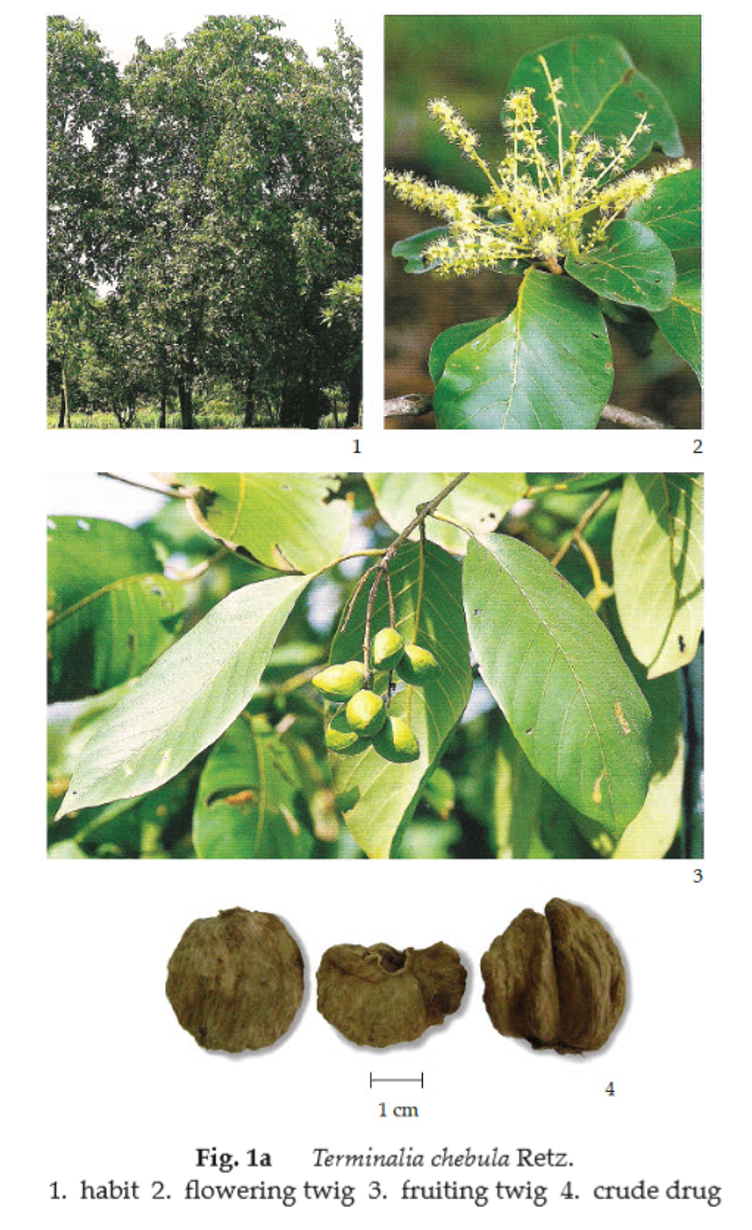
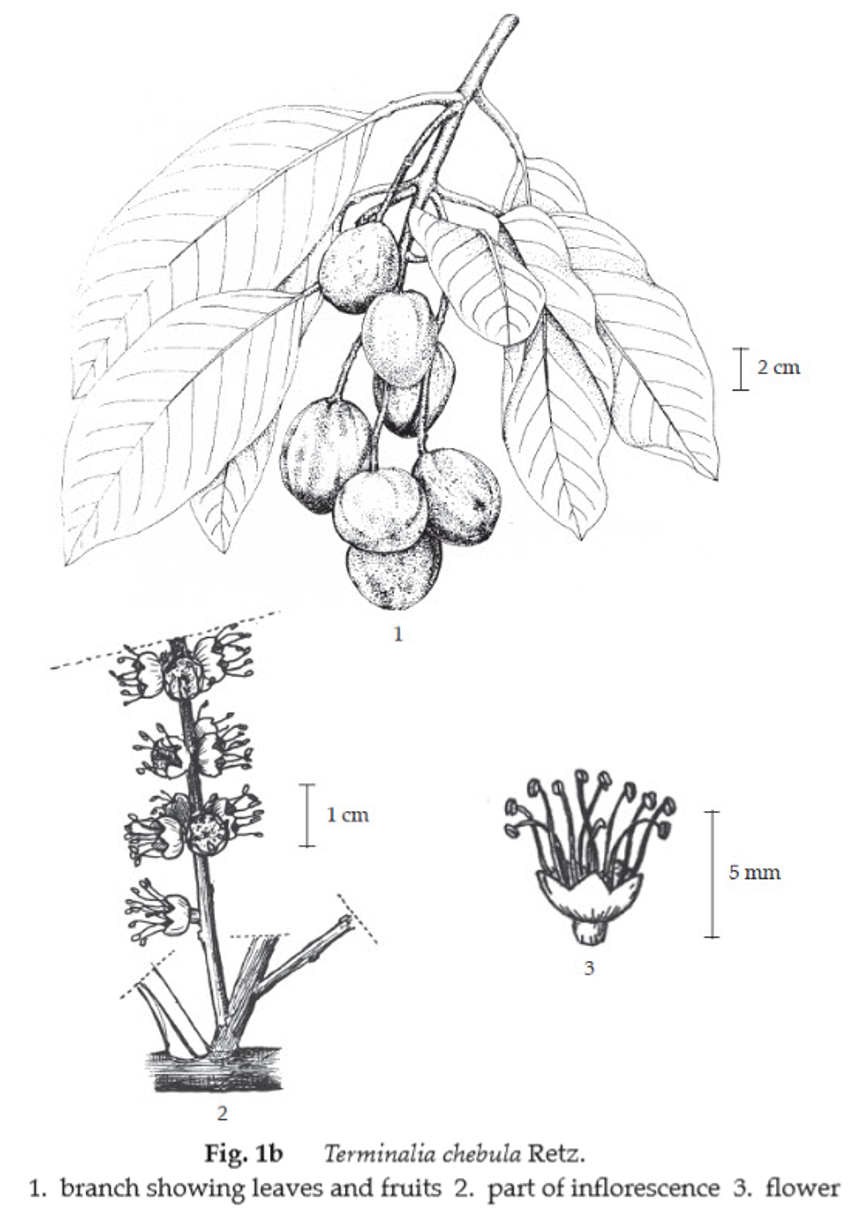
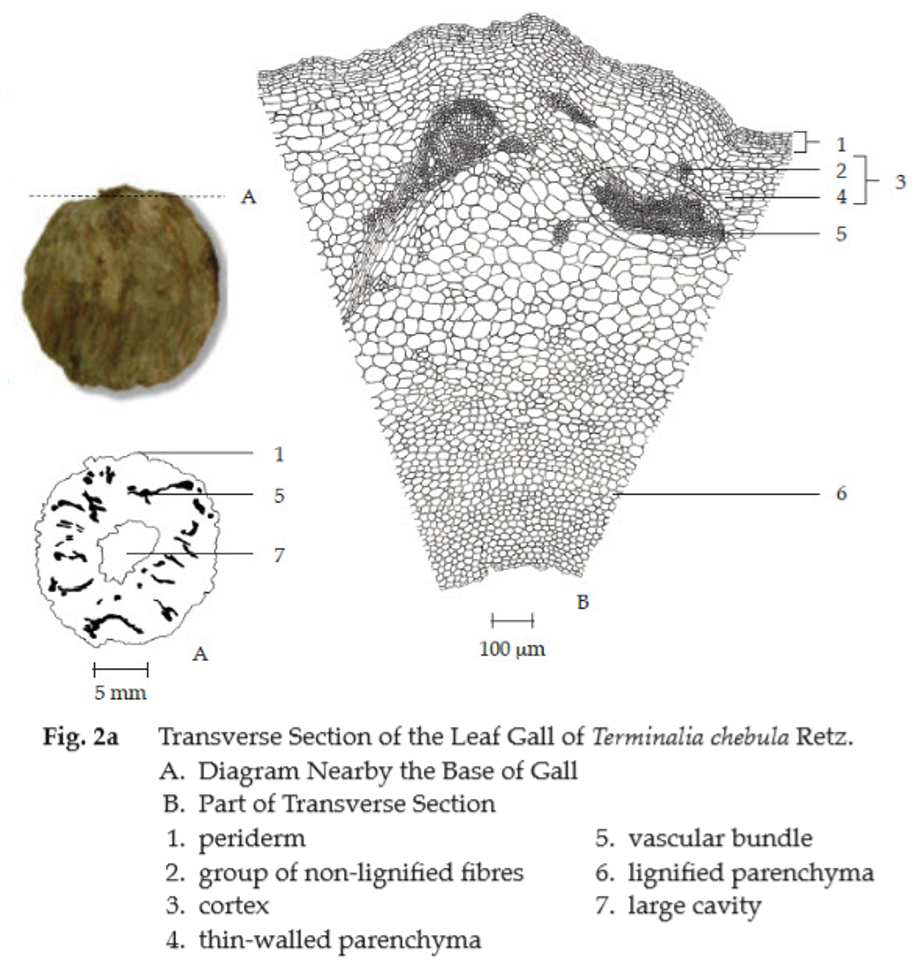
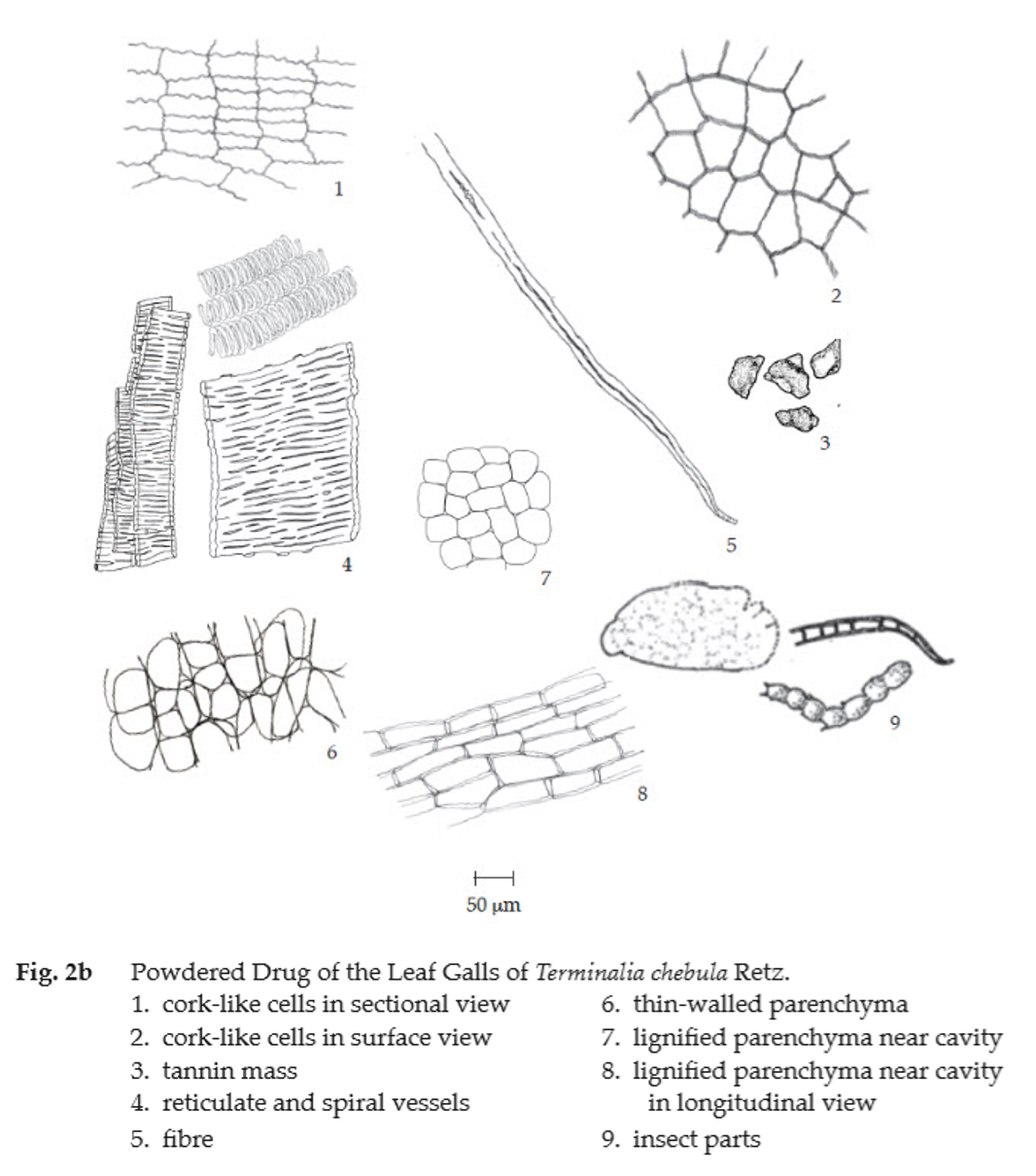
Additional information It is commonly used with other herbal drugs in Thai traditional herbal preparations.
Packaging and storage Terminalia Chebula Gall shall be kept in well-closed containers, protected from light, and stored in a dry place.
Identification
A. Heat 500 mg of the sample, in powder, with 10 mL of water in a water-bath for 10 minutes, allow to cool and filter. To 2 drops of the filtrate, add a few drops of a 1 per cent w/v solution of iron(III) chloride: a dark green colour is produced.
B. Heat 200 mg of the sample, in powder, with 10 mL of water in a water-bath for 5 minutes and filter. To 2 mL of the filtrate, add a few drops of a 1 per cent w/v solution of gelatin: a yellowish cloudy precipitate is produced.
C. Carry out the test as described in the “Thin-Layer Chromatography” (Appendix 3.1), using silica gel GF254 as the coating substance and a mixture of 100 volumes of ethyl acetate, 11 volumes of formic acid, 11 volumes of acetic acid, and 10 volumes of water as the mobile phase and allowing the solvent front to ascend 10 cm above the line of application. Apply separately to the plate, 5 μL each of the following solutions. Prepare solution (A) by refluxing 1 g of the sample, in powder, with 25 mL of water for 30 minutes, filtering and evaporating the filtrate to almost dryness. For solution (B), dissolve 2 mg of gallic acid in 1 mL of methanol. After removal of the plate, allow it to dry in air and examine under ultraviolet light (254 nm), marking the quenching spots. The chromatogram obtained from solution (A) shows a quenching spot (hRf value 84 to 89) corresponding to the gallic acid spot from solution (B). Spray the plate with anisaldehyde TS and heat at 110° for 10 minutes; the spot corresponding to gallic acid is brown. Other several brown spots also appear (Table 1); see also Fig. 3.
Table 1 hRf Values of Components in Water Extract of the Leaf Galls of Terminalia chebula Retz.
| Spot | hRf Value | Detection | |
| UV 254 | Anisaldehyde TS | ||
| 1 2 3 4 5 6 7* |
25-28 30-37 41-47 48-51 56-63 70-73 84-89 |
quenching quenching quenching quenching quenching quenching quenching |
- - brown brown brown brown brown |
*gallic acid
Loss on drying Not more than 13.0 per cent w/w after drying at 105° to constant weight (Appendix 4.15).
Foreign matter Not more than 1.0 per cent w/w (Appendix 7.2).
Total ash Not more than 4.0 per cent w/w (Appendix 7.7).
Ethanol-soluble extractive Not less than 42.0 per cent w/w (Appendix 7.12).
Water-soluble extractive Not less than 50.0 per cent w/w (Appendix 7.12).
Tannins content Not less than 30.0 per cent w/w (Appendix 7.21 H). Use 4 g of Terminalia Chebula Gall, in powder, accurately weighed.
